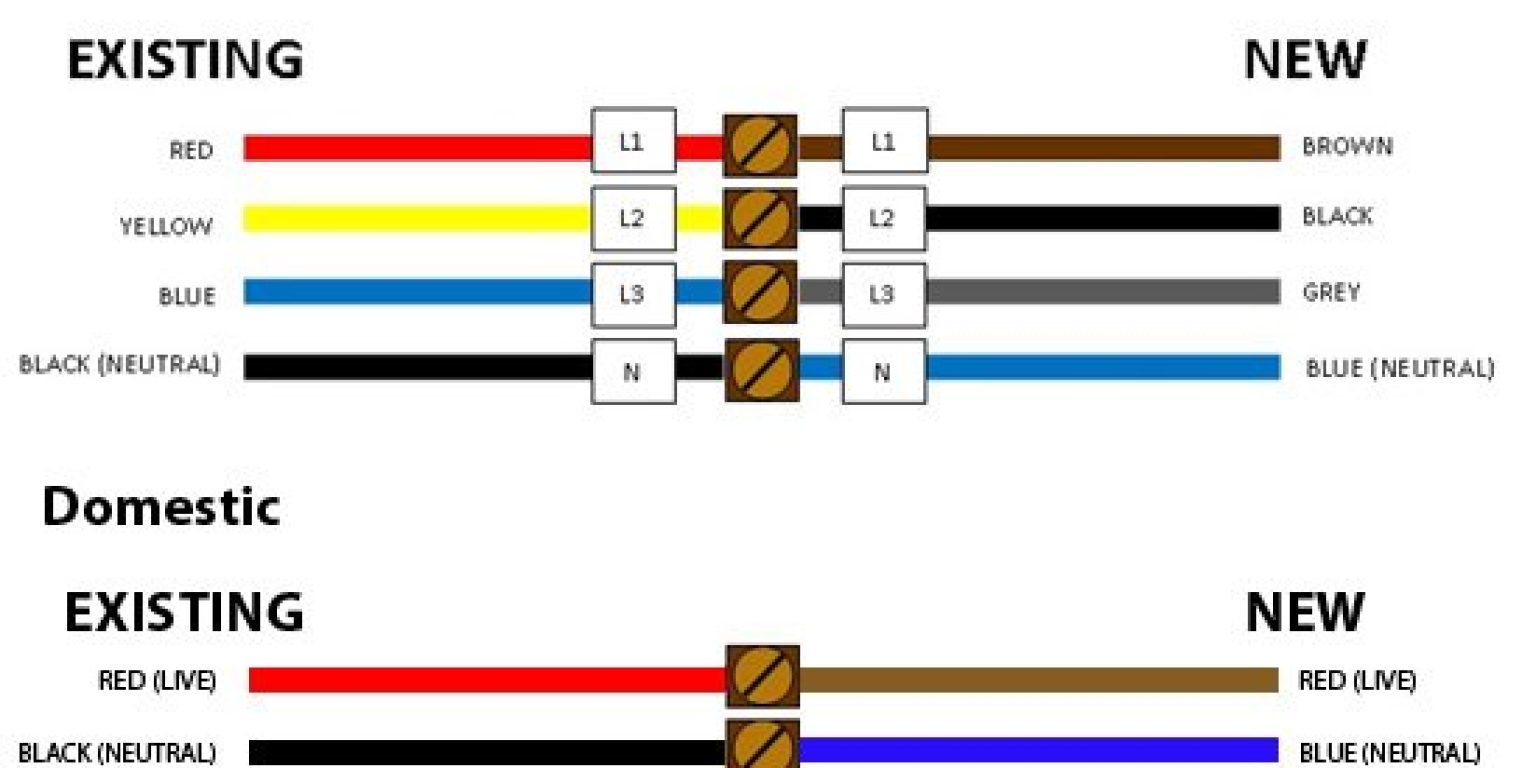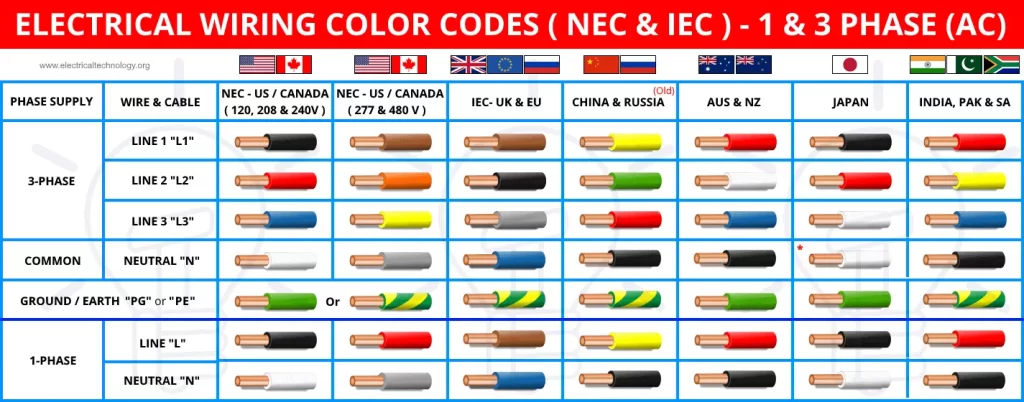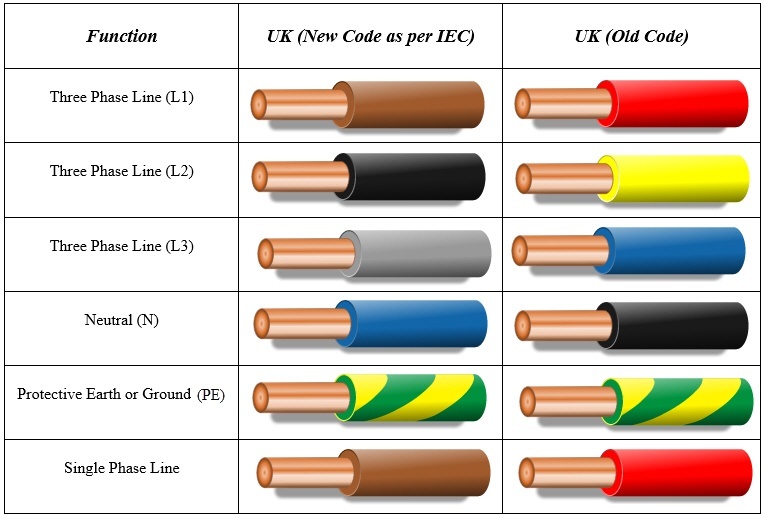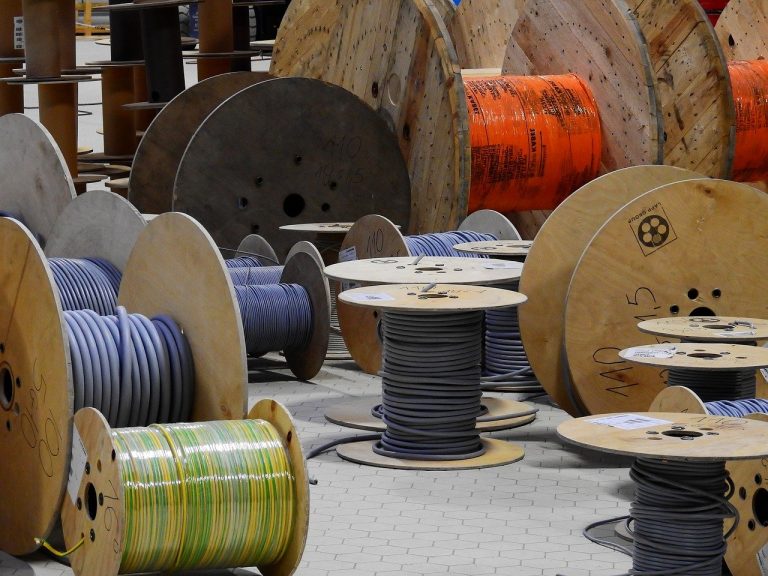Understanding electrical wiring color codes is essential for electrical safety in your home. Many people don’t know the basic electrical wiring color code standards used in their homes; electrical wires are colored differently depending on their purpose and following electrical safety best practices.
Knowing the difference between positive and negative colors for wires is vital to ensure you’re not causing problems like electrical overloading or fire hazards. Do you know the UK & US have different color codes?
If you’re planning to work on any electrical wiring project, you must understand the color coding associated with wiring; whether you’re installing a new light fixture or replacing an outlet, knowing how to correctly and safely identify which wire is which can save time and avoid potential safety hazards.
This guide will give you all the information about your home’s wiring color code standards.
The National Electrical Code (NEC) For Colour Coding
The National Electrical Code (NEC) is a set of safety regulations and code of practice for electrical wiring installations in the US. It sets out the rules for safely approving, installing, and maintaining electrical systems.
The NEC has established an industry-wide standard for color coding of wires. This color coding helps to ensure that the correct wire is connected in the right place and prevents the mixing up of wires, which can cause hazardous and potentially life-threatening situations.
Knowing the NEC electrical wiring color code standards is a must-have for any budding electrician, and even if your skills are limited to changing a lightbulb, it’s good to be informed. The National Electric Code (NEC) outlines clear guidelines for properly color-coding wires and cables used in electrical installations.
Electrical wiring color code helps electricians quickly diagnose and repair problems since each circuit stage is colored differently, allowing you to easily distinguish between different electrical wiring color code. The NEC divides electrical wiring into three distinct categories:
- Hot (live or active)
- Neutral
- Ground
Each category has a different electrical wiring color code. Wiring for AC, DC, and other special applications will also have their color coding standards, but the most commonly used electrical cable colors coding standard is set out in the NEC.
US electrical wiring color code standards are quite straightforward and logical; the 3 phase color code is the same whether you’re wiring a 120V or a 277V circuit. An electrical cable color code chart is available at most hardware stores to help you make sure the wires are connected properly.
Electrical Cable and Wire Color Markings
Every home or office has a different wiring and cable color coding system. Generally speaking, dc voltage wire color code, alternating current (AC) wire color code, and grounding wire color code vary depending on your region. So it’s important to know how these codes work together before jumping into a wiring project.
1. Red Wires: Hot
Red wires are hot and carry the power from the breaker panel to a device or switch. They can also be used in some types of three-way switches.
Red wires usually indicate the secondary live wires in a 220-volt circuit, used in some types of switch legs and in the interconnection between smoke detectors that are hard-wired into the power system.
2. White Wires with Black or Red Tape: Hot
White wires with black or red tape (or paint) around them are also considered hot. They are commonly found in three-way switch configurations, where a single white wire is used instead of two wires for the switch legs.
When this type of white wire is connected to a device, it should be marked with black or red tape (or paint) to indicate that it is a hot wire. In-home electrical wiring color code, white wires are usually used as a neutral path back to the electrical panel.
3. Green and Bare Copper Wires: Ground
Every home should have a grounding system to protect against accidental shock. The green and bare copper wires in your electrical panel are the ground wires that return excess electricity to the ground when there’s an overload or short circuit.
It’s important to know how these two types of wires interact with each other so you can make sure they are properly connected during installation.
4. Bare Copper Wires: Ground
Bare copper wires are used as ground wire in almost all electrical systems. They are connected directly to the grounding system, typically at the main service panel or sub-panel.
All bare copper wires should be securely connected with a set screw or clamp, so they don’t become loose over time. Often, bare copper wires will be encased in a metal sleeve that protects from abrasion or corrosion.
5. Black and Blue Wires: Hot
Do you know what is black wire for electrical wiring? Black and blue wires are hot, which means they carry the power in.
They can also be used to create a three-way switch configuration depending on how they’re connected. It’s important to ensure they are properly secured with wire nuts or other fasteners before use. The phase 3 (i.e., black) wire should always be marked with a label or taped off to indicate it’s the phase 3 wire.
6. Green Wires: Ground
After the grounding wires, you’ll also find green wires in most home electrical wiring systems. Green wires are used for grounding and should be securely connected with a set screw or clamp, so they don’t become loose over time. If the wire is encased in a metal sleeve, it should still be connected to the grounding system.
7. White or Gray Wires: Neutral
White or gray wires are neutral and provide a return path to the main service panel. They should be securely connected with wire nuts or other fasteners and marked with labels or taped off to indicate neutral wires. The live wire color should never be used in place of the neutral wire.
8. Blue and Yellow Wires: Hot
These wires indicate a hot connection. They are used in conduits and switch legs, providing a path for the energy to flow from the power source to the desired device. They are known as travelers because they allow the energy to travel from one switch to another.
UK Wiring Colors
Struggling to understand the electrical cable color code in the UK?
Time for an electric shock of information. The UK’s wiring colors are, quite literally, the backbone of all electrical installations, and knowing how to use them correctly is paramount.
For a successful installation, the electrician should attach corresponding colored insulation, sheathes, or sleeving to each wire for easier identification. Doing so will ensure that all wiring is properly identified and labeled for future use. As mentioned before, the black neutral wiring has been superseded by blue-colored wiring.
Likewise, red live electricity wires have now become brown. To guarantee the safest wiring installation, both old and new cables should be prominently marked with their respective color codes. This will prevent any confusion in connecting the phase to neutral correctly.
While some types of cables in the UK have similar coloring to mains wiring, let’s take TV aerial cables as an example. These cords are color-coded brown, like live electrical cabling; however, they do not carry voltage.
Regularly, you might notice black wire or cabling disguising the back of your TV. This is usually similar to the hue of vintage neutral wires. If uncertain, it’s best to reach out to an electrician to perform a thorough inspection and guarantee safety.
Old and New UK Wiring Colours
According to 1960 electrical wiring color code regulations, the old wiring colors were:
- Red – Live wire
- Black – Neutral wire
- Green/Yellow – Earth Wire
The new wiring colors for the UK are:
- Brown – Live wire
- Blue – Neutral wire
- Green/Yellow – Earth Wire
It is important to note that both old and new wiring colors are still in use, although the newer scheme is more likely to be encountered.
International Electrical Wiring Color Codes
The UK is not the only country that employs different electrical wiring color codes. Different nations use varying standards to distinguish the types of wires and their potential uses. For example, in North America and most of Europe, live cables are colored red and neutral wires are black or blue.
It is important to know these variations when working in different countries. IEC and Canadian Wire Color Codes differ from the UK’s wiring standards, and one should always double-check before connecting any live or neutral wires.
● IEC Wire Color Code
The International Electrotechnical Commission (IEC) has established a set of wire color codes that different countries use to identify various electrical wiring colors in their respective homes and businesses.
The IEC electrical wiring color code is a two-letter system that assigns a letter, signifying the primary color, and a number indicating the secondary color of an electrical wire. Most European countries, except Italy and Germany, use this color coding standard.
● Canadian Wire Color Codes for AC Power
The Canadian Electrical Code (CEC) uses the same color code as the US. Canadian electrical wiring standards require black, red, and blue insulated wires to be used in 120-volt applications. The white neutral wire is connected to a silver-colored terminal block.
Green or green with yellow stripes are used for grounding purposes, while orange indicates a switch leg. If you’re looking for the Canadian Wire Color Code for AC power, here’s everything you need to know:
- Black – Hot (Phase)
- Red – Hot (Phase)
- Blue – Neutral
- White – Neutral
- Green or Green/Yellow Stripe – Grounding
Conclusion
For anyone dealing with electrical wiring, it’s important to know the basics of electrical wiring color code. That includes understanding the purpose of each wire, what the colors mean, and which colors are specific to certain types of circuits. With some knowledge, you can save time and money when troubleshooting or replacing any wiring in your home.
ZW cables are the trusted source for all your wiring needs, so don’t hesitate to reach out for assistance in understanding the electrical wiring color code. We’ll be happy to help you with any questions or concerns regarding your current electrical setup and how it can be improved. With our expertise and knowledge, you can trust that your home will remain safe and wired correctly for many years.
Last Updated on December 28, 2023 by Richard





